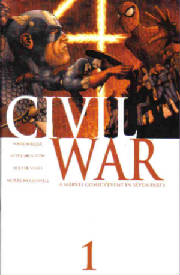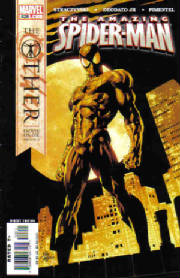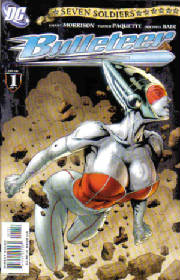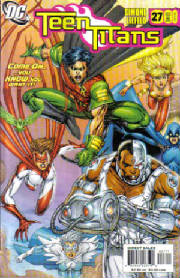CIVIL WAR 1. Every now and then the comic companies come out with a storyline in which either the public or the government loses faith and trust in its super-heroes and wants them to be more accountable. Occasionally the public is manipulated by villains [such as DC's Legends mini-series in which Darkseid was pulling the strings], sometimes there's a rotten apple in the white house, and sometimes everyone just gets a little sick and afraid of super-people. In this interesting variation, the heroes of the Marvel universe are told that they should register and not use their powers until they have been trained and their abilities honed to a fine degree. To some heroes this seems like common sense; it will not only make the heroes more effective in the long run but will help keep them alive. But other heroes hate the idea of "registering" and revealing their identities and all the hassles that doing so will engender. The Fantastic Four counter that their identities have been known all along and they've been around for years. And so on. Adding to the angst is a battle between some neophyte heroes with their own reality TV show and some deadly villains [Nitro, for one] which ends with a suburban area being decimated and dozens of innocent deaths. Although Nitro is the cause, many feel that had the heroes had better training, they could have rounded up the bad guys and prevented such a disaster. The heroes are taking sides against each other, and of all people, Captain America is leading the fight of the rebels. This promises to shape up as a much grittier, more interesting mini-series than DC's Infinite Crisis, but time will tell. Don't worry about reading all the tie-ins; the main story is in the mini-series.
SUPERMAN/BATMAN 26. Although I pretty much gave up on this series quite a while ago - it had some nice moments and stories but just wasn't my "cup of tea" -- I picked this one up because it appeared to be a tribute to the late Connor-Superboy. Actually, it's a very moving tribute to young Sam Loeb [the fifteen-year-old son of writer Jeph Loeb], who died of cancer. The boy's story has Robin and Superboy taking on the menace of a new, very young Toyman and is fun. However, the part of the book that really grabs you is the back-up in which Sam himself becomes a childhood friend of Clark Kent, who is both stricken and inspired by his fate. Deeply moving. A very touching tribute to a very nice young lad who died much, much too soon. Our hearts go out to his parents.
INFINITE CRISIS/52. DC Comics. So now that the fuss is over I'm afraid I have to say that DC's Infinite Crisis mini-series wasn't much for them to crow about. The original Superboy from the sixties is improbably turned into a murderer, desperate to save his universe and remain the One True Superboy. He goes on a rampage, tearing off heads and arms. A bunch of villains get involved, there's the usual cosmic shake up, and at the end the new Superboy - Connor - is dead. Some of the artwork by Jiminez and Perez is quite nice, and the mini-series has its moments, but Crisis on Infinite Earths it ain't. A lot of hype over little. And to follow this up, DC has come out with the longest maxi-series ever, 52, which will take an entire year to play out. What DC wants to do is play up its lesser lights while Superman, Batman and Wonder Woman go off to find themselves after the events of the latest crisis. I'm sorry, but if you want to rivet the readers' attention you might consider that the last way to go about it is to focus on such loser characters as Booster Gold, who was always pretty much a complete zero, Skeets be damned. I've read the first two issues, but this is one 52 week ride I'm not going along for.
AMAZING SPIDER-MAN # 528 and other assorted Spider-Man issues presenting The Other: Evolve or Die mini-series parts 1 - 12. Various writers and artists. Well, now that The Other is finally over, we can assess its strengths and weaknesses. The main plot had to do with Peter Parker being killed, then sort of shedding off his old body, winding up in a cocoon, and emerging better than ever - but a little weird and changed. And let's not forget "the other" creature that came out of this whole process, a more arachnid-like being comprised of thousands of spiders [who ate the husk of Peter's body] and seems to have an agenda all its own. Although the story arc held the attention and was undeniably suspenseful, there was nothing all that special about it. What's needed in Spider-man isn't gimmicky plots or major changes but simply good stories that make good use of both new and old Spider-villains, of which there is a rich assortment. However, if the series creates a new interest in the character for bored or disinterested readers it will have served its purpose.
TEEN TITANS # 30. Johns/Daniel/Alquiza. I remember those superb Marv Wolfman-George Perez Brother Blood mini-masterpieces and have to wonder if this new creative team ever read them and found out what a super-hero book should be like. For unaccountable [and undoubtedly silly] reasons, the story in this ish is framed by a kid reading a Captain Carrot comic book, with the lousy artwork from the comic within a comic reproduced [and taking up valuable space]. The basic idea - Brother Blood using deceased Titans such as Kole, Jason Todd and others to fight the TTs - isn't bad, but the execution is pretty dismal. Tony S. Daniel's pencils don't really cut it, and this version of Brother Blood completely lacks the dynamism and dramatic panache of the original. Pretty much a waste of money.
REALLY BAD COVER #1. JLA 123. The story inside - concerning the new, deadly powers of the old villain The Key set off against the strain inside the league - isn't bad, but why on earth would any editor sign off on this dreadful cover? Sure, it does sort of suggest the league "splitting up" and Donna Troy [bottom right] does guest star in the issue, but it says absolutely nothing about the story and certainly isn't the type of dynamic illustration that would tempt a recalcitrant reader into picking up a copy of the comic. The art itself is amateurish and the composition is lousy. This is no way to sell a magazine. Luckily the inside art is somewhat better.
THE BULLETEER # 1. DC Comics. Part of the new "Seven Soldiers" series, this looks better than most of the others and may even manage to have a life after the inevitable cancellation of the other books. A big part of the reason for this is the attractive and dynamic artwork by penciller Yanick Paquette and inks by Michael Bair. To be fair, writer Grant Morrison has also come up with an interesting way to reinvent the old Bulletman and Bulletgirl characters. In this our heroine is married to an ambitious man who has come up with Smartskin, which will not only keep you from getting wrinkles but make you invulnerable. He has a strong desire to become a sleek and sexy superhero. But something goes wrong while he experiments with the formula and both he and his wife wind up covered with a sheathe of metallic-like skin. The husband dies, and the woman becomes a freak who has no real choice but to accept her fate and her ability to become, ironically, a super-heroine. This one has real possibilities. Wait and see.
DOOM PATROL # 15. The Man Who Lived a Lifetime. Written and pencilled by John Byrne. Inked by Doug Hazlewood.. Okay, it's hard to figure out if DP is worth reading and collecting or not because of its hit or miss quality. Byrne's decision to scrap everything and start as if the DP were a brand new group immediately eliminated all of the group's rich history. The decision couldn't have been made because Byrne found the adventures of the original DP too silly, as his own stories can be pretty childish at times. The art and stories seem to indicate that this book is geared for younger readers, then along will come this issue, which is pretty grim for such a book. Taking a cue from Proteus of the X-Men, a character Byrne drew and probably had a hand in creating, Byrne offers a baby who is an energy vampire and who starts sucking the life out of everyone - doctors in the delivery room, his mother, babies in the maternity ward and so on - even as he rapidly reaches maturity. He isn't "evil" as such, just extremely deadly. The book is full of horrors that Byrne's artistic, almost cartoonish style can't really delve into with any great impact; the expressions on the faces are too superficial to convey all the anguish and terror the characters must be feeling. Considering all the heartbreak embodied in the story - what about the parents of the dead babies and high school kids, for instance? -- Byrne wraps the story up too quickly and we're on to another silly adventure. This should have taken up two issues at least. The Byrne/Hazlewood art is attractive enough in its way, and smooth, but there's something lacking. You get the feeling Byrne has lost his enthusiasm and is just doing this one for the money. Perhaps he did this "horror" issue to flag up sales? In any case, DP still manages to hold the attention in a limited way - but for how long? UPDATE: Not much longer. The new DP comic's final issue came out in November 2005. The Doom Patrol may be fondly remembered, but this incarnation will not be especially missed.
TEEN TITANS # 27. The first issue of a two-parter with story by Gail Simone and art by Rob Liefield. The story introduces a group of not-very-interesting spoiled metahumans who take innocents hostage and try to get millions even though they're the offspring of wealthy parents. Then the agent of the Lords of Chaos, Kestrel, frees two of the group from capture and the Titans enter the fray... Oh, yes, they also go bowling [that's right -bowling!] You probably won't care to read part two after reading part one - I certainly don't. Simone's script is mediocre, and Liefield's art, while undeniably striking at times, features those unreal, artificial, frozen poses that indicate he still has lots to learn about anatomy and drawing the human figure. I've given up hoping that TTs would ever resemble the Wolfman/Perez series, but I did think this latest incarnation of the group would be better than previous attempts. We'll have to see what happens once this two-parter is wrapped up.
GREEN LANTERN # 4 (2005). "Alienated." GL investigates when a supposed "alien" is found who turns out to be a human who was shunted forward in the evolutionary scale - just like old GL foe Hector Hammond. GL goes to see humongous-headed Hammond (who wants him to mind-share one of his sexual experiences with him) and learns that certain parties deliberately sent the meteor [the one that changed him] to Hammond and are now continuing their "experiments" on other people. Before GL can learn who these parties are, we're onto a post script which shows the horrifying return of The Shark. Normally I can do without frat-boy type gross-outs in superhero comics, but the gruesome final panel of GL # 4 packs a wallop. [Let's just say we finally see The Shark doing what comes naturally.] I can not applaud the return of Kilowog, a character I never cared for, but I am excited that writer Geoff Johns is bringing back old GL foes in very inventive ways (there's even a cameo by Sonar). This is enough to get me thumbing through my old GLs and looking forward to the next issue of this new series as well.. Ethan van Sciver's artwork isn't quite perfect but it is rather nice and generally attractive. There's also a great full panel showing GL stepping into Hammond's prison cell. The first few issues were a little disappointing, but this new GL/Hal Jordan series might be one to watch for!
FANTASTIC FOUR # 530. As I enjoyed the new film version of this comic so much, I thought I'd check back in on a series I'd pretty much given up on. Part of the problem is - and remains - the art. I am just not a fan of Mike McKone, whose work seems too cartoonish for my taste. I thought Mark Waid could write some awful stories but I'm afraid that the new scripter, television writer J. Michael Straczynski, might be even worse. In this issue the team encounter an evil-looking alien that is actually a seeker of truth and has been condemned to death - along with the Earth, apparently - because of it. I won't be back for the big battle in the next issue. Straczynski has The Thing say "ya think?" like something out of a sitcom twice in one issue. He seems to have no real feel for our fabulous foursome; it's just an assignment. This is by the numbers comic book writing completely lacking the excitement of the Lee/Kirby days, or even John Byrne's run on the series. Too bad.
FLASH 220 and on. "Rogue War." The idea of Flash's Rogue's Gallery dividing into two factions and fighting, with Flash caught in the middle, is a good one, but the art in this series pushes you out of the story instead of pulling you in. Despite an occasional dynamic panel and effective page layout, Howard Porter's pencils, inked by Livesay, are ugly in composition and poor in anatomy, and the guest pencillers haven't been much better. Geoff Johns' stories have interesting elements and ideas to them, but apparently they are not artist-proof. Johns' work adds some psychological "depth" to the series that is welcome, many of his story ideas are solid (and occasionally confusing, or is that the art?), but Porter's sloppy-looking, unattractive pencils just ruin it all. It's heady to contemplate what a great series this might be if a more appropriate artist were assigned to the adventures of the super-speedster. You buy The Flash, you read it - but it's hardly a must-have that you've got to keep in your collection.












